C. Litka's Blog, page 42
June 11, 2021
Shadows of an Iron Kingdom Blurb
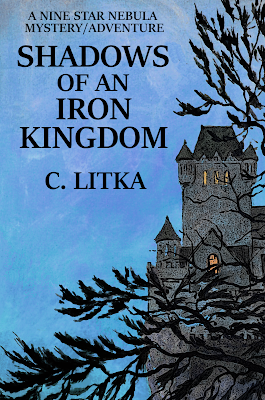
Below is the first draft & unproofread version of Shadows of an Iron Kingdom's blurb.
“I’d like to believe that I can take the rough with the smooth. I didn’t complain about the hundred petty inconveniences of the Iron Kingdom. Not too much. It was thewerewolves, superhumans, and mad scientists whohaunted its black forests and ruined castles that got to me. Still, what did I expect in the company of Vaun Di Ai?” – Rafe d’Mere from Shadows of an Iron Kingdom.
Rafe d’Mere and Vaun Di Ai return once more in this sequel to The Secrets of Valsummer House. Rafe d’Mere, after turning the Fix-it-all Shop back over to its owner, follows his heart instead of his head. Concerned, after not receiving a radio-packet from Lieutenant JG Vaun Di Ai for months, he sets out for the planet of VanTre to assure himself that she’s fine. There, he finds that she has resigned from the Patrol – an unthinkable act on her part. So, with some help, he follows her to the small, airless planet of Ironlode, merely to find out what she’s gotten herself into this time. It was danger, of course. Danger in a Gothic inspired throw-back society. A primitive, almost feudal society where mythical werewolves, the size of large bears, were said to roam its dark forests. They proved to be more than imaginary. And even so, they weren’t the most dangerous creatures that inhabited those forests. Di Ai, d’Mere, and Di Ai’s colleague, the all too handsome and charming (in d’Mere’s opinion), Tarvis Byn, set out to find the secret of these monsters.
Shadows of an Iron Kingdom is the third book in the Nine Star Nebula Mystery/Adventure series. Set in the same universe of The Bright Black Sea, these stories chronicle the early adventures of a character we first met in The Bright Black Sea, Systems Tech Rafe GilGiles, a man of a hundred names.
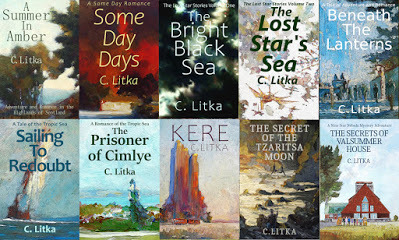
June 9, 2021
Shadows of an Iron Kingdom Cover
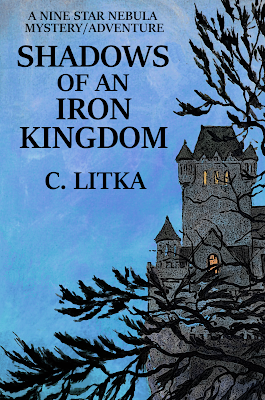
Above is likely the cover for my next book. Font, font size, and text placement may be tinkered with, but the art is a done deal. This is actually the second attempt at a cover. The first one was just too bad -- I used part of it to illustrate the blog post below. Originally I wanted the scene to be at sunset, so I painted the sky in yellows and oranges. But the mood I want is sort of Gothic gloom, and I think the blue sky works better to achieve what I can of that mood. But you can judge for yourself, as below is the sunset sky version. The color change was done digitally in Gimp, so it is the same painting.
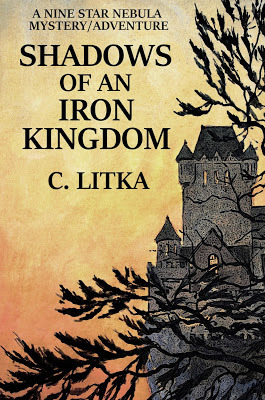
If any of you have a preference, drop me a line in the comments section. I would be interested in hearing your thoughts.
And just for shits and giggles, below is my first attempt at a cover. Not only is it is too primitive and half-assed, but there is no place to put a title that can be read. There was a time that I might've been able to bring off a piece like this, but that was a time when I still had the patience to take my time and work at it. That time has passed.
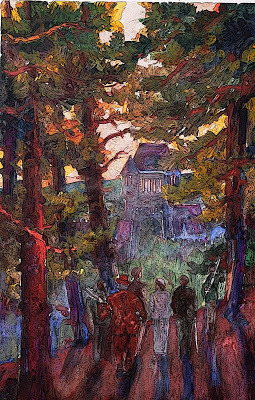
I will no doubt use parts of this piece for the back cover illustration for the paper version -- it will be small, and likely only the castle part. Nothing goes to waste.
June 4, 2021
Shadows of an Iron Kingdom - Done
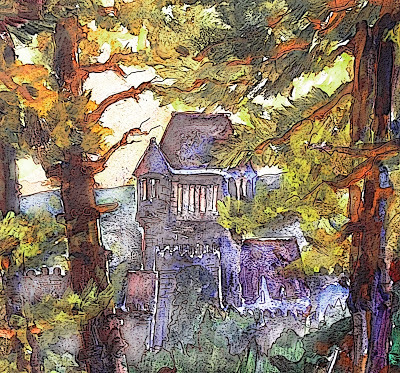
Just a quick update this week. I finished writing the third Nine Star Nebula Mystery/Adventure -- Shadows of an Iron Kingdom -- this week and have turned it over to my first proofreader, my wife. After she goes through it, I will send it along to my volunteer beta readers for their input and corrections. I anticipate its release in the first half of July 2021.
I finished the first draft on 2 May 2021, took a couple of weeks off to work on another project, and returned to do the second and third draft, finishing the third on 2 June. I wrote the first two drafts in LibreOffice. This time, I uploaded the second draft to Google Drive, and did the third draft in Google Doc. Google Docs has a more robust grammar checking feature than LibreOffice, highlighting correctly spelled, but wrong words which LibreOffice doesn't do.
I am nearly completely blind to typos -- I "read" what I expect to read, regardless of what is actually written, and so, despite my best efforts, my manuscripts are riddled with typos. I'm always looking for ways to lesson the burden on my proofreaders.
For the last book I uploaded the manuscript to Google Doc after the final draft, but this time I decided to combine making the corrections it found with my third draft. After going through it once, I downloaded back to a LibreOffice format, and then uploaded and converted it back to a Google Doc just to see if it would find more errors, as it doesn't always find all of them, for some reason, things like the most obvious ones -- double words. It highlights some, while overlooking others. Anyway, the second run though did find more mistakes -- some of which I may have made in my corrections. Which would seem unlikely -- but then, well, I'm good at making mistakes. But to be fair, LibreOffice does not underline typos until after you enter the next character, which, when going through the manuscript making corrections, the previous correction may well be off screen by the time you type in the next character, thus, you never see your new typo... That anyway, is my story, and I'm sticking with it. In any event, running it through Google Doc the last time significantly cut typos -- but did not eliminate them, as I had hoped. We'll see if this method of double checking yields a better result.
I haven't written the blurb yet, nor painted an acceptable cover, so those will have to wait until next week.
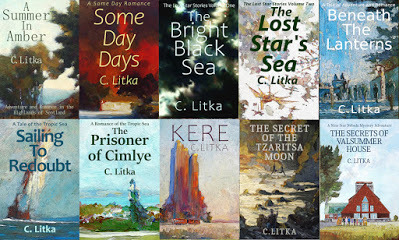
May 28, 2021
Writing on the Edge
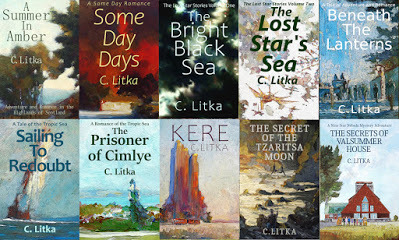
The edge in the title is end of writing for me. I have no idea how close it is. I can’t see very far into the future. With any luck at all, I’ll die before I reach it. But you never know. It's one of the reasons why I make it a point to sit down at my desk almost every morning and write for several hours. I’m afraid that if I stop for too long, I’ll find it hard to get back into that habit again.
This fear is not unfounded. I’ve drawn and painted my whole life – and I have a couple thousand paintings in a closet to prove it. But, after struggling for six years to come up with subjects to paint that interest me, I’ve finally given up painting. Indeed, I almost hate painting today. These days I only do it, gruelingly, for my book covers. Most of my paintings came from my imagination, the same place my stories come from. And if that wellspring of painting ideas could dry up, so could the wellspring for my stories. Indeed, it is far more likely, since I’ve not one of those writers who have so many story ideas that they don’t have time to tell them all. I have to work to come up with every story, and don’t finish all of the ones I do come up with. So it’s a real possibility that the next story I write will be my last. If that happens, I’ll have to find a new creative outlet – planning ahead, I think it’ll be game design.
At present I’m finishing up the second draft of Shadows of an Iron Kingdom. Its still on track for a July 2021 release. I’m more than halfway through the first draft of A Starfaring Life, a novella that I am writing for an upcoming Amazon iOS app dedicated to serial stories. I’m looking to write 20 episodes of around 1,000-1,500 words each. This will be my starship space opera. I’m writing it mostly as an exercise in free advertising. So I've got stuff coming up for the next six months or so. But after that, nothing.
Well, not quite nothing. I have an idea of the type of story I’d like to write. I’m currently working on the setting -- a minute here, 30 seconds there.... But as yet, I don’t actually have a story. Moreover, I want to write a longer novel than my last five books -- something in the 100-120K words range. And even if I come up with a story, I don’t expect to start putting it into words until sometime in the fall. So there is going to be a break of several months when I’ll not be writing. Well, it’s summer and I never want to be inside in our all too brief summers, so it’s not unusual for me to take some sort of break during the summer. Still, and idea is not a story, and not writing is not writing, so we’ll see how close to the edge I am.
May 21, 2021
Shadows of an Iron Kingdom
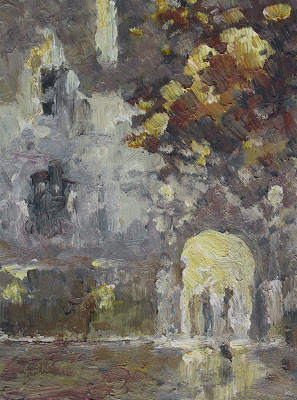
Shadows of an Iron Kingdom is my current working title for my next novel, and likely its final title. The story is the third book of my Nine Star Nebula Mystery/Adventure series, and the final one, for now. I'm going to take a break from that type of story to try a few different story ideas next. Once again this story features Rafe d'Mere, and Vaun Di Ai. It is, however, set on an entirely different world -- Ironholm, a minor airless planet dominated by a dissenting throw-back society that exists in rift valleys under the domes. This society is much more primitive than Fairwaine's Agrileaa Co-op -- something like the Transylvania of gothic fiction.
So it should come as no surprise, given the setting, that I'm going for a Gothic vibe in this mystery adventure, complete with ruined castles, beasts like werewolves, people like vampires, and the odd mad scientist. The final version of the Iron Kingdom the story is set in a little more "modern" setting than I when I had first imagined the idea for the story, as the demands of moving the story along seemed to require more than horse drawn carriages and dark little villages in darker forests. I haven't written the blub, so I'll save more details for another post. At present I'm working through the second draft, and I expect to have it to my proof and beta readers early in June -- on target for an early July release. I've also sketched out my first attempt at a cover. Stay tuned for more details.
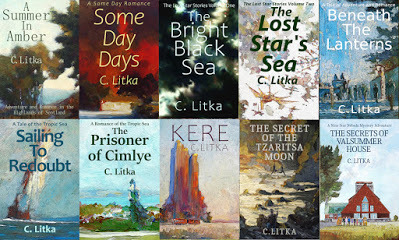
May 14, 2021
Rejection
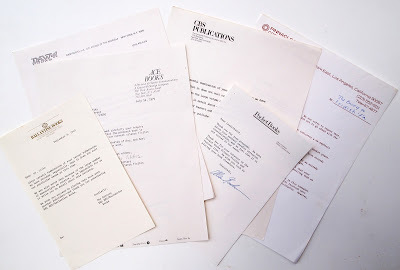 Rejection letters from Ballantine, DAW, Ace, CBS (Fawcett), Pinnacle and Pocket Books
Rejection letters from Ballantine, DAW, Ace, CBS (Fawcett), Pinnacle and Pocket BooksI’ve known rejection. In 1979-80 I submitted one fantasy novel, The Envoy to Ividish'fa alternate title: The Brigand Sea Prince (72,000 words) one science fiction novella, The Hybrid-Worlder, (29,000 words, revised down to 21,900 words) and one science fiction short story, Death on Glou'ay (4,500 words). They were one and all declined by the paperback and SFF magazines of the day. Still, I though it might be interesting to share my modest collection of rejection slips with you. I should point out that my collection is modest because I did not have the persistence you need to get published. I gave up too easily. And when, some 35 years later I once again had complete stories to publish, I didn’t even bother to submit them to traditional publishers. I’d either publish them myself, or bury them myself.
Above and below are my collection of form letter rejection slips for the major mass market publishers of science fiction and fantasy of the time for the Envoy to Ividish'fa/The Brigand Sea Prince.
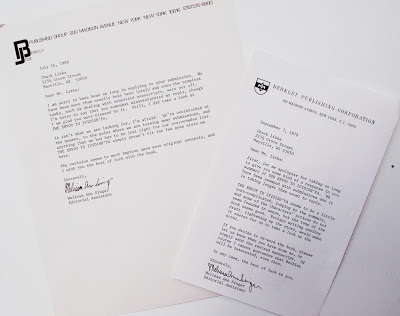 Rejection Letters from Berkley-- personal responses from Melissa Ann
Rejection Letters from Berkley-- personal responses from Melissa AnnSinger
The lower right letter dated Sept 7, 1979 from Melissa Ann Singer, Editorial Assistant said that the story seemed " a little over-complicated," and that "some of the character's actions did not seem founded in sense." She did say that the tone of the book "seems good," and suggested another draft, tightening up the story. The upper letter left letter dated July 16 1980 is again from Melissa. In it she said that she did take a look at it, but that it isn't what they are look for. She kindly said that the revision (apparently I revised it, hence the two titles) "seems to much improve upon your original synopsis."
Below are three more rejection letters for the fantasy novel, The Envoy to Ividish'fa, including a xeroxed letter with Lester de Ray's signature, apologizing for having to resort to a form letter. He reports that a series of personal and business emergencies made it impossible to keep up with his normal schedule. And that he insists on reading and considering every fantasy submission personally. He had no "first reader" to expedite these reports, hence the need for the form letter.
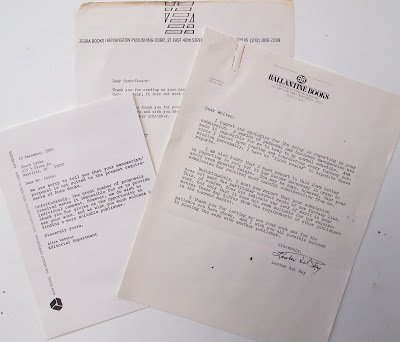 Rejection letters from Avalon, Zebra Books, and Ballantine again, with Lester de Ray's signature (not original -- a xerox copy
Rejection letters from Avalon, Zebra Books, and Ballantine again, with Lester de Ray's signature (not original -- a xerox copyBelow are rejection letters from Analog and the Magazine of Fantasy and Science Fiction.
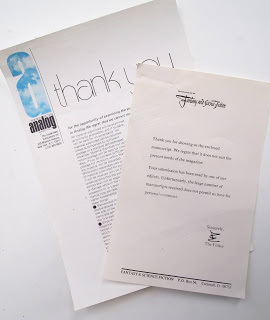
Below is a note from Amazing Stories/ Fantastic Stories concerning my sf novella, The Hybrid-Worlder. The fist one is dated 9/10/79 from Omar Gohagen, telling me to send along the novella. "although it will need to be judged exceptional by all of our reading staff to qualify as a novella for publication. Advice: try to avoid too much wordiness. Keep it tight. If it's exciting action -- there will be enough wonder."
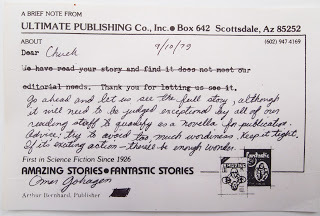
I apparently sent a revised version of the story, tightening it up from 29,900 to 21,900 words to them and here is their response (two sides), this time from Britton Bloom: You can read what Britton Bloom says, but note that under what needs work, only the "action" box is "x"-ed. Then, under the "We would like you to:" section, the "Send us other stories" box is "x"ed. Which actually is pretty encouraging... Though I don't know how encouraging it was for me at the time, since, well, I didn't ever follow up on it...
Anyway, what I found interesting on the back side was the line "The phrasing has a 17th century sound that seems out of place in the future." The sf author Nathan Lowell talked about The Bright Black Sea that he was reading in several of this "talking while walking" podcasts, and in one he talked about how old-fashioned my writing sounded. It seems that some things never change. I don't do it deliberately, I guess I just like the old fashioned way of writing -- though I don't think it's 17th century. Late 19th -- early 20th century. Britton goes on to say that "the length of your sentences makes the work slow needlessly. Tighten up, make shorter punchier sentences.' Good advice, I've been making a point to do exactly that, these last couple of books. The note ends with "And let us see what they look like, (something-- hey -- maybe)?" Looking back 40 years, that was a pretty positive response. I should've tried harder and written more stories.
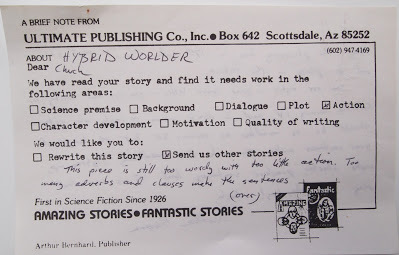
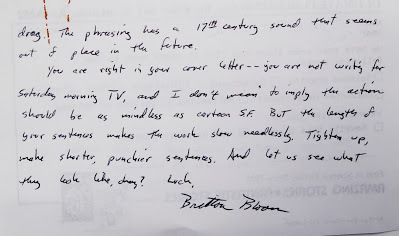
And finally two rejection slips for Asimov's SF Magazines, one initialed by George Scithers, the other signed by Darrel Schweitzer, assistant editor. These are rejecting my short story Death on Glou'Ay.
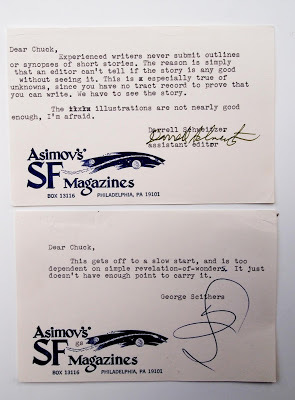 Rejection slips from Asimov's SF
Rejection slips from Asimov's SFI have a terrible memory about my life, so that looking over these rejection slips brings back no memories. Even so, I find them interesting in that in many ways, they could still be written about the stories I've written and am writing today. I'm probably still to wordy. While I'm trying to eliminate long, run on sentences, I find that I'm constantly having to go back and break them apart. Still, while I haven't the courage to actually go back and read these things, I'd like to think that I've gotten better with age and practice. They say that you should shove your first novel in the drawer and keep it there. I've given you pretty much all of my late life writing, so I guess these stories will have to count as my novels in the drawer.
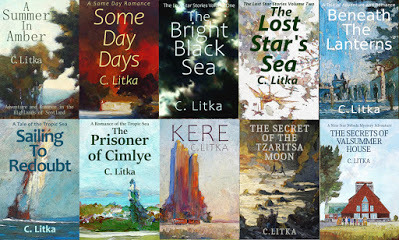
May 7, 2021
First Draft of My Next Book Done!
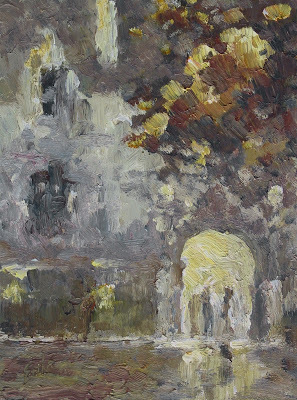 Probably not the cover -- but the mood.
Probably not the cover -- but the mood.As always, I’m delighted and relieved to report that I finished the first draft of my next novel. I’m a person who never likes anything, good or bad, hanging over my head, and that includes an unfinished story. This is especially true when I don’t have a clear picture of the story details when I start. So it is always a relief to know that a story well over half done, with only the part that I really enjoy -- tinkering with the words -- in my second and third draft. So even though there's still a couple of weeks worth of work ahead, the heavy lifting is done.
My first file for this book is dated 20 January – four lines, just to break the ice, so to speak. Between 21 February and 22 February I wrote two pages. I got seriously down to business on 4 March. I wrote for a total of 21 days in March. I devote 1 ½ to 2 hours each morning to writing with an occasional evening session as well. I don’t have a daily word count goal – I never have trouble typing words if I know what I want to say. In the middle of March, I took a few days off, as I had overrun my imagination, and had to stop and think about where I was going. I even spent a day typing out a outline of the remaining story -- something I never do. A chronology, yes, so I know the time line, but a two page written outline. Nope. Until now. I had to pause several times in the process of writing this story. On those days, I'd go back and start my revision process until I figured out how to push ahead. I wrote every day in April and finished the first draft on 2 May, missing my target date by those two days in May. All in all, it took me two months to write a relatively short, 67K novel.
Ideally I have the story in my head in its entirety before I sit down to write it. Usually I’ve gone over key scenes in my mind time and time again. These days that hasn’t been the case. Part of it is that I’m writing more, but shorter stories these days, starting the next one within days of finishing the last one. It’s a case of making hay while the sun shines. I have some story ideas, and I want to keep the creative juices flowing. I’m afraid that if I get out of the habit of daily writing, it will be hard to get back into it again. I’ve seen my spring of inspiration dry up when it comes to painting, and I have to believe that the same thing can, and someday will, happen with my writing as well. As I said, making hay while the sun shines.
So what’s this next book about, you ask. Well, I think I’ll save most of the details for a future post. I’ll only say that it is the third and, for now, last Nine Star Nebula Mystery/Adventure novel in this set. And it should be ready to be released in early July 2021.
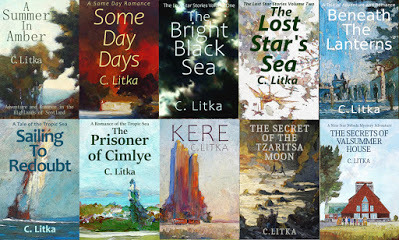
May 1, 2021
Six Years in Self-Publishing
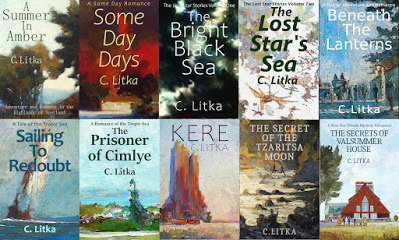
Well, well, here we are, six years after I self-published my first novel, A Summer in Amber. So where in the blazes are we? We're not in Kansas anymore. And it ain’t 2015 anymore either. Looking around, self-publishing is very different industry from the one I started out in 2015.
In 2015, self-publishing was in the final stages of its gold rush era. I released three very different books for free, and without any effort or money spent promoting them,I gave away more than 6,000 of them between Amazon, Smashwords, Apple, Barnes & Noble, and Kobo. Customers of those stores were still happening upon one's books back then.
Fast forward to 2021. Those days are long gone. Big entrepreneur/writer/publishers, some who even employ ghost writers to write the actual stories, now dominate Amazon. Today they need to spend thousands, if not tens of thousands of dollars on ads and crank out books every couple of months just to maintain their readership. Beyond Amazon, Smashwords has changed their format to one that seems to favor best sellers. B & N's ebook store has faded, as have my sales on Apple. Kobo -- who knows? They don't report free sales. The bright spot these last two years is that readers are finding my books on Google Play Books -- somehow I sold more books on Google than I did on Smashwords/Apple by a long shot, this past month.
Long story short, I'm quite certain that if I did today, what I did six years ago, I'd count myself lucky if I did 10% of the business I did back in 2015.
Luckily, over the past six years I've managed to built a modest readership, one that I'm quite happy and thankful for. To be honest, I don’t think I’d enjoy being wildly successful – what with all the demands on your time that comes with the territory. I have just the sort of readership that I’m comfortable with. A good readership. I like’em.
Year Six Results
So how did I do in my sixth year as a self-published author? The numbers are below, so you can judge for yourself.
Year five was my best year ever, though I didn't expect it to continue, given the way the ebook market was evolving. This year my four to six year old books did half the business they did last year, though my space opera, The Bright Black Sea remained my bestseller.. However, I released two novels and a novella this year, and while none were breakout hits, they shored up my sales, so that year six turned out to be better than I had anticipated.
The three new books this year were my Mars novella, Keiree, and two Nine Star Nebula Mystery/Adventures, The Secret of the Tzarista Moon, and the Secrets of Valsummer House, plus one children's short story, that I had laying about for a decade: Lines in the Lawn, (on Smashwords only). I’m writing shorter stories these days, as I find them much easier to dream up and write down.
I also revamped my covers this year. I never see any difference, but it keeps me amused.
And, as usual, my odd, mostly foreign Amazon store sales pretty much cover my expenses (paper books for my beta readers) so that if I'm in the red, it's pocket change. Being a self-published author is an inexpensive hobby for me.
Year Seven Expectations
Next year? I’m going to go out on a limb and say, it will be pretty much like this year -- and almost every other of the last six years. It will depend on how many stories I can write and release. I'm currently within a day or two of finishing the first draft of my next and last Nine Star Nebula Mystery/Adventure book for this set of books. I should release it in early July 2021, at the latest.
My next project will be to try writing a 30-35K word novella in 60 short episodes for a new venture by Amazon called Vella. Vella will be an iOS only Amazon app designed specifically for serial stories in the 600-5,000 word per episode range to be read primarily on iPhones. My idea is to use this format as a vehicle for reaching readers who never bother searching beyond their Kindle Unlimited selection, which my books are not enrolled in. It remains to be seen if I like writing in this format and whether or not I pursue it beyond experimenting with it. Other than that, I've not settled on any definite next story. After producing four books in twelve months, I think that I can take the summer off to come up with some new story ideas. We'll see.
Six Year Numbers.
As usual, "sales" are mostly free downloads. Numbers are approximate, likely due to quantum fluctuations. i.e. I'm 11 books off from last year's total.
Book Title / Release Date
Year Six Sales
(#) Year five Sales
Total Sale To date
A Summer in Amber
23 April 2015
598
(818)
7.816
Some Day Days
9 July 2015
358
(726)
4,211
The Bright Black Sea
17 Sept 2015
1,320
(2,656)
13,816
Castaways of the Lost Star
--
2,176
The Lost Star’s Sea
13 July 2017
986
(1,962)
6,969
Beneath the Lanterns
13 Sept 2018
551
(1,087)
2,792
Sailing to Redoubt
15 March 2019
728
(1,043)
2,332
The Prisoner of Cimlye
2 April 2020
632
(244)
877
Lines in the Lawn
1 July 2020
83
83
Keiree
17 Sept 2020
853
853
Secret of the
Tzarista Moon
19 November 2020
1,110
1,110
Secrets of Valsummer House
18 March 2021
265
265
Total 6th Year Sales
7,484
43,300
Yearly Sales History:
Year One, 2015/16: 6,537 (3 novels released)
Year Two, 2016/17: 6,137 (1 novel released)
Year Three, 2017/18: 6,385 (1 novel released)
Year Four, 2018/19: 8,225* (2 novels released) * includes a strange 1950 book one day sale on Amazon that they say is correct. (6,275 w/o)
Year Five, 2019/20: 8,530 (1 novel released)
Year Six, 2020/21: 7,484 (2 novels released, 1 novella, 1 children's short story)
Past Yearly reports can be found here:
Year 1: https://clitkabooks.blogspot.com/2016/05/a-window-to-self-publishing.htmlYear 2: https://clitkabooks.blogspot.com/2017/05/two-years-of-free-books.htmlYear 3: https://clitkabooks.blogspot.com/2018/05/3-years-in-self-publishing.htmlYear 4: https://clitkabooks.blogspot.com/2019/05/four-years-in-self-publishing.htmlYear 5: https://clitkabooks.blogspot.com/2020/05/five-years-in-self-publishing.htmlYear Six Sales by Outlets
Over the last year my sales by digital storefronts were: 40% from Amazon, 40% from Smashwords (+ Apple & B&N) and 20% from Google.
Note: Kobo does not report free sales to Smashwords. Barnes & Noble's numbers no longer appear on my daily sales record. However elsewhere I find that I sold 128 books in 2020, and 40 in 2021 to date on B & N.
The trend here is that both Smashwords and Amazon are fading, while Google is stepping up to fill in. Amazon is up and down. I've had a good couple of months in 2021 on Amazon. In March, not only did I have a new release, but The Bright Black Sea received a nice writeup on the blog of Nathan Lowell, a popular SF author, which together produced a near record month for free books, and a record month for actual mioney sales of some 120 copies. That trend faded a bit in April, but it was still a solid month. The other bright spot in 2021 are my sales on the Google Play Store. They have been rising all year. In March they essentially matched my Smaswords sales, and in April 2021 they almost doubled my Smashwords sales. This increase in Google sales has helped keep my yearly sales in my usual range.
Summing Up Six Years of Self-publishing
I've done exactly what I wanted to do. Write. I've gotten to know some of my readers, some of whom have kindly volunteered to be my beta readers. And they have made a appreciable difference in the quality of my books. I have made an effort to write better in little ways, and I'd like to think that I've had some success. Covers have become a pain to paint, but other than that, I've got the whole process of self-publishing down pat. And I'm still having fun doing it all. I'm looking forward to my seventh year report.
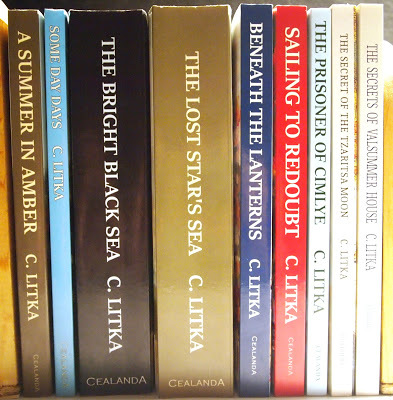
April 25, 2021
My Library -- Old Comic Strips
[image error]
I was not into comic books in any big way as a kid. I can only recall one that I bought for a train trip. I did read a friend’s more extensive collection of comics, but comic books weren’t something I spend my allowance on. As an adult there was perhaps half a decade when I collected comics, because of a friend of mine who was into them. We got to drawing our own. I’ve posted several pages of my work on a SF story this blog a few years ago. You can find them here:Sarfeer Page 1
Though I collected several superhero comics in this period, I also collected and enjoyed the classic Bark’s Scrooge and Donald Duck comics a lot more. I found that superhero comic basically consisted of a recap of the last issue, followed by a bar fight, with nothing ever resolved. And like soap operas, no one ever really dies in comics.
I suspect that around this time I either purchases or received as a gift the book pictured at the beginning of this post, the Smithsonian Collection of Newspaper Comics. It offers over 300 pages of comics from the turn of the last century into the 1060’s. Given my interest in drawing comics at the time, this offered s a treasure house of ideas and techniques to draw on. But more than that, it brought back memories of the Sunday comics I always looked for each Sunday while growing up – and the memory of the strange comics that I’d come across when we were visiting relatives.
As it turned out, people have gone back and collected many of those old comics and offered them in nice big books, that I’ve collected over the years – more for the art than the stories. Though I must admit, never a complete set, save one.
Gasoline Ally was an early comic centered around a single man raising an orphan, along with the early years of automobiles, hence the title. The Sunday spreads were often very creative, as you can see from the sample from the Smithsonian book above.
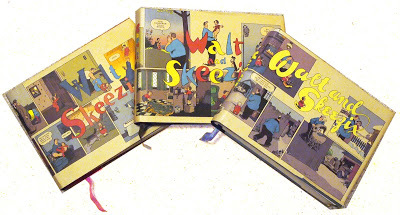
While there is a volume devoted to a sampling of the Sunday color strips, it’s a little too expensive for my taste. I did, however, invest in the first three volumes devoted to the first several years of the daily B&W strips. What I found interesting about them is the parallel between the early automobile enthusiasts, as depicted in the strip, and the early computer enthusiasts. Pioneering car owners of the 1920’s and computer owners of the 1970’s and early 80’s seemed much alike, forming clubs to celebrate their new enthusiasm, exchange knowledge, and to debate the merits of their favorite car or computer.
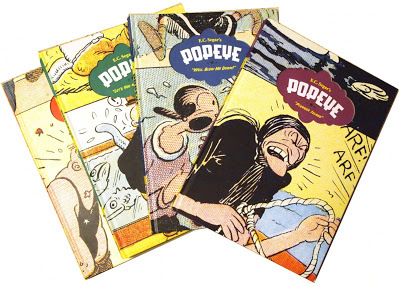
I was, and likely still am, a big fan of the original Popeye cartoons. I loved the gritty art of those Max Fleischer cartoons. The comic Popeye was somewhat of a different character, and the stories much more involved. Indeed, one of the Popeye stories served as an inspiration for a scene in A Summer in Amber. As before, I don’t have the complete Segar collection of Popeye strips, but a good sample of the early stories
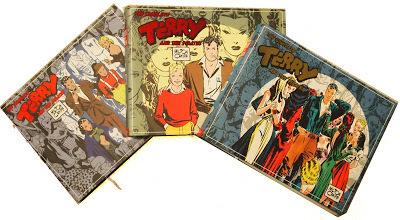
I was too young to ever read Terry and the Pirates, but I’d come across enough references to the strip, and seen samples, so that I picked up the first three volumes. In the war years everyone was fighting the Japanese or Germans, so the stories were all war stories, which doesn’t interest me, so I stopped once the series got into the 1940’s.
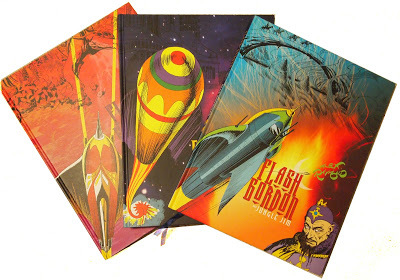
Flash Gordon was another series that I read – growing up. Indeed, I used to clip out the strips in the daily version (and threw them away a couple of years ago.) However, I these Alex Raymond original were released long before my time. Again, I stopped at the war years. It is interesting to see how Raymond’s art became more and more polished as the strip went on. I also have comic book versions of this Jungle Jim series and his style is perhaps my favorite of all the comic book artists – spare, and yet atmospheric.
Prince Valiant was one of the Sunday Comics that our local newspaper carried when growing up. I can’t say that I was ever entranced by the story when I was growing up, but as an adult, and as an artist, I really appreciate the fine art of the series.
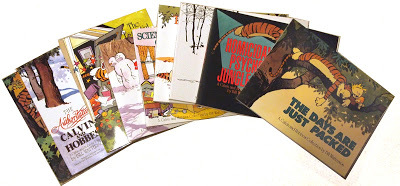
Last, but not least, I have all the Calvin and Hobbs strips – in their various book releases rather than the big two volume set. This collection is for everything about them. It was the best comic strip ever written. Period. And that’s all that need be said.
April 21, 2021
Om Adams Kon Illustration
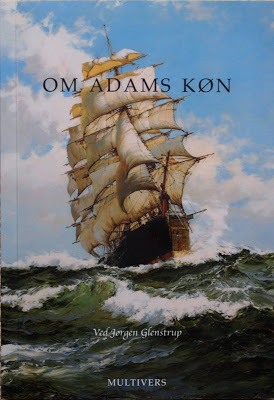 Front Cover -- Not my artwork
Front Cover -- Not my artworkJust a quick post today to send a “heads up” to all my Danish readers, and readers of Danish. (That’s a joke, son.) Multivers has release a new book with the title of Om Adams Køn, Den Klassiske Fortaeller, edited by Ved Jergen Glenstrup. (About Adam’s Sex, The Classic Narrator)
It is a collection of short stories by the likes of Thomas Mann, Joseph Conrad, and others along with essays. The Google lens translation of the introduction is rather cryptic, so I can’s say much about it. But what makes it noteworthy is that if you turn it over and view the back of the book, you will find one of my early tea clipper ink drawings, no doubt tied in with the Joseph Conrad story, The Secret Sharer or The Double as it is titled in this book. The drawing is also used in the interior.
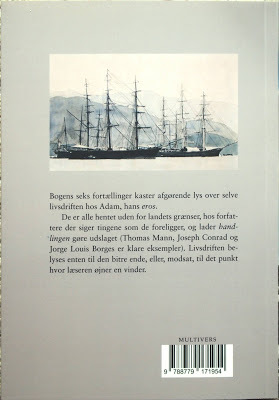 My Ink Drawing of Tea Clippers at Foochow Anchorage, from a Photo
My Ink Drawing of Tea Clippers at Foochow Anchorage, from a Photo
The publishers contacted me after seeing the drawing on my Deviant Art Gallery https://www.deviantart.com/litka and asked if I would be willing to let them use it for the book, and for how much. I agreed, of course, for a copy of the book, which I now have.
Ah, such dizzying success so late in life! I’m lucky, in a way. It would have no doubt gone to my head if it all happened sooner. Anyway, pick up your copy today, its a handsome book and they’re very nice people.



